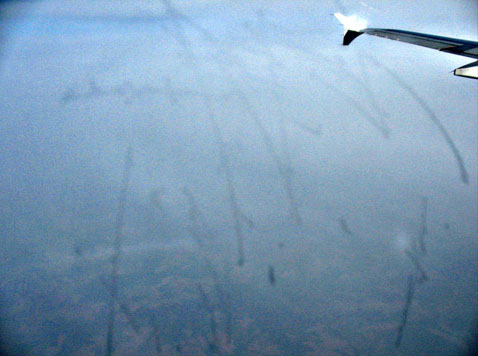Monday, 19 October 2009
Sub-120° parhelion photographed
Starting from the 1970's we have seen numerous photos of subparhelic circle opposite to the sun and it is a little wonder that sub-120° parhelion has never been observed from an airplane. Even the sub-Liljequist parhelion, of which formation is sensitive to crystal shape deviations from regular hexagon, and which from that point of view should be rarer than sub-120° parhelion, has been photographed a couple of times.
Well, given enough time, things are bound to change. On 31 July this year sub-120° parhelion was finally photographed. The man behind the camera, Tomas Trzicky, was on a return trip from watching a total sun eclipse in China. The halo display appeared on the last stretch of this trip, on its last hour, when the airplane started descending to Prague.
"I was really lucky - actually I was sitting in the isle during most of the flight, one member of our observing group left her window seat for a while, so I more or less routinely checked the white haze outside - and there it was :-)", tells Tomas.
The sub-120° parhelion was captured on two photos, click on the image above to see them. To the left from the halo is a patch of subparhelic circle, which most probably is sub-Liljequist parhelion. Further left, in other photos, subanthelion and faint diffuse anthelic arcs crossing it are also visible ( 1 ). The window was dirty and it was frosty, but it just adds to the magic of discovery.
These photos may explain why sub-120° parhelion has not been captured earlier. It occurs as an isolated white spot, without subparhelic circle crossing it. Unless being exceedingly bright, it must be easily missed. Most certainly sub-120° parhelion has occurred in all of the displays with subparhelic circle, because plates are the major contributor to subparhelic circle intensity. Subparhelic circle made solely by Parry orientation is more of a theoretical consideration, and columns do not make subparhelic circle at all.
Sub-120° parhelion has been photographed once earlier in spotlight beam in diamond dust ( 2 ), but Tomas's "old school" observation is of course the true discovery. See also Les Cowley's report ( 3 ) on the case.
Labels:
Displays
Subscribe to:
Post Comments (Atom)

Congratulations, Tomas. This is halo-history. The first sub-120 by the sun.
ReplyDeleteI start having the feeling that this season will be another special one!
It is good this one fell on a halo person. And for a Czech halo person. Czech network has done impressive work during their short existence and they deserve this.
ReplyDeleteYes, I second Marko's comments.
ReplyDeleteFantastic! The long wait is over.
ReplyDeleteWow finally sub-120d parhelion from the sun finally photographed. Fine job tomas you got r done!!
ReplyDeleteThanks for your post!
ReplyDelete